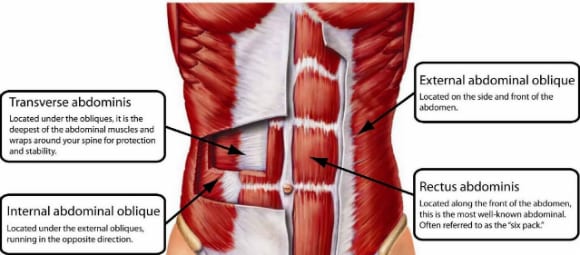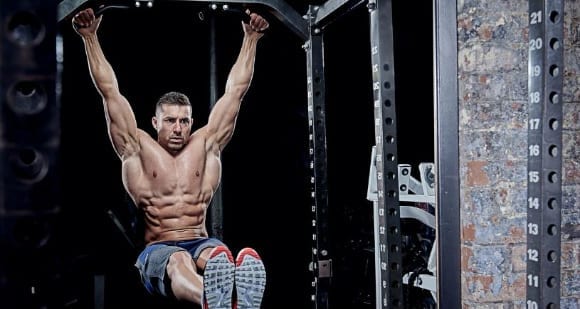
By Myprotein Writer
Jamie Wykes Hobday
The abdominals are comprised of four muscles that work synergistic-ally to function and protect the internal organs.
These muscles include;
1) The TVA (Transverse Abdominis): Positioned under the obliques and stretches around the spine for stabilisation and protection.2) Rectus Abdominis: Found on the front of the abdominals area, this is the section most commonly associated with the ‘6 Pack'3) External Obliques: placed on the side of the abdominals.4) Internal Obliques: Unsurprisingly, these are found under the external obliques.

A general misconception about the abdominals is that they are all of the core muscles, however, the core is comprised of five muscles, of which only two are located in the abdominal area;
1) Transverse Abdominis (Abdominals)2) Pelvic Floor3) Internal Obliques (Abdominals)4) Diaphragm5) Multifidus.
It is important that we do not confuse the two; the abdominals are commonly trained for aesthetic appearance whereas the core is trained for stability, performance and function.
Whilst there has been heavy discussion about to what extent you should train the abdominal muscles, what cannot be denied is technically; they are just like any other muscle. For this reason alone, they should be trained like any other muscle; with resistance, frequently and with the aim to generate progressive overload.
The Hanging Leg Raise Exercise |
Benefits
One of the most common exercises used to target the abdominals is the ‘hanging leg raise’, a movement applied to target the whole torso whilst also incorporating levels of balance and stability. Benefits include: ? Improving grip strength? Latissimus dorsi engagement? Practicality (they can be performed anywhere, as long as you have something to hang from!) Now we have become familiarised with the anatomy of the abdominals and the hanging leg raise exercise, lets take a look at how to perform the exercise correctly.How To Perform

1) Applying either a close, medium or short grip; grip the pull up bar from above and hang from it with both arms and legs fully extended.
At this point the whole body should be extended and relaxed.
2) As you exhale your breath, raise the legs to a 90 degree angle.
Exhaling your breath during abdominal exercises is key due to the fact that it can intentionally tighten the abs throughout the movement whilst also assisting with correct form and tempo implications.
3) Once the point of contraction has been reached, if you can, hold and engage the abdominal muscles.
4) Whilst breathing in, slowly lower your legs back down to the starting position.
5) Perform for the preferred amount of repetitions.
Common Mistakes
? Diving Straight Into It
Some people may jump straight into the exercise and as a result they perform the exercise poorly and potentially injure themselves. However, like almost any exercise, there are regressions to be implemented. A regression is defined as a less or former developed state; essentially meaning an easier form. This is extremely beneficial for many reasons; helps build confidence, develop kin-aesthetic feel and also to improve poor form.
Regressions of the leg raise include lying knee raises, forearm leg raises, hanging knee tucks and more. A training partner or ‘spotter’ can be greatly utilised in this as they can assess form and technique from an unbiased perspective.
? Getting Complacent With It
Opposite to struggling with this exercise, the same should be applied to those finding the exercise too simple. In training, you should never get complacent when an exercise has been mastered; constantly think ‘progressive overload'.
A progression is the process of developing gradually to a more advanced state. Just like regressions to exercises, there are also progressions respectively. So, for those who have mastered the hanging leg raise and find it ‘easy’, here are some progressions to keep your training stimulating and varied; dumbbell hanging leg raises, toe to bars, hanging windmills. Try these out!
? Training Abs Everyday
As stated earlier, the abs are like any other muscle. Abs need recovery too, training them everyday is just going to hinder this. Incorporate abdominal training into your routine but allow yourself at least 72 hours recovery between each time you train them, depending on recovery rate.
Add some more resistance, make the exercise harder and slow the movement down; try these and you should certainly be feeling sore and less keen to train them again the next day.
? Overtraining
Too much inner abdominal pressure can either aggravate or lead to a hernia. Hernias usually happen when the body has been exerted massively in a short period of time and occurs when there is a hole or weakness in a muscle wall which is keeping abdominal organs in place.
Abdominal hernias are the most common form of hernias and are usually the result of strain via excessive ab training. In order to prevent this from occurring, train smart and know your body limits; if you feel an abdominal pain occurring, consult your doctor right away. If you do have an abdominal hernia and still want to train, try to avoid the aggravated muscles; train around it.
Whey ProteinLean muscle
Foam RollerFlexibility
MaltodextrinEnergy
BCAA'sMuscle recovery
Our articles should be used for informational and educational purposes only and are not intended to be taken as medical advice. If you're concerned, consult a health professional before taking dietary supplements or introducing any major changes to your diet.








